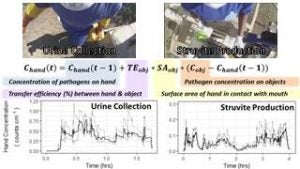Sanitation sewers are expensive and in many low-income urban settlements, they are infeasible. Container-based sanitation offers a low-cost option for affordable sanitation.
In order to improve the safety of container-based sanitation systems, I worked with Tim Julian and Tamar Kohn’s teams as Eawag and EPFL to evaluate microbial health risks for sanitation service workers employed in a container-based urine collection system in Durban, South Africa.

Unlike a typical honey bucket or “luggable loo” portable toilets, the containers used in Durban’s system divert urine away from feces and into a 20 L jerry can that is connected to the outside of of the latrine structure. The cans are hauled away by hand and the urine was processed into a struvite fertilizer.
We modeled this process using videography and field sampling to assess the transmission of human pathogens in the urine. The handles and outside of the jerry can used to transport the urine were the greatest source of risk in the process and should be disinfected regularly to reduce potential microbial health risks.
The Container-based sanitation alliance (https://www.cbsa.global/) offers a great resource for learning about entrepreneurship in this space that is bringing safe and affordable sanitation into the reach of families and communities in dense urban areas.
Our manuscript is now available in Environmental Science & Technology and will be open access thanks to the Bill and Melinda Gates Foundation.